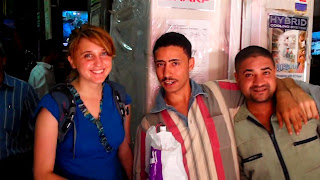Here is a compilation of excerpts from the journal I'm keeping while I'm here. Hopefully they'll give a decent image of the area we are working.
On first entering Mokhattam, the first thing you notice is that the paced road transitions to dirt. The ratio of cars to donkey carts shifts heavily in favor of the latter. The buildings are easily ten stories, all apartment-style--one window with no glass. There is garbage on the streets. Not litter--garbage. Six-foot high by ten-foot wide heaps of it, as though someone took one of the large commercial BFI bins and just emptied it right there on the side of the road. There are abundant stray cats and dogs, and, of course, there are the flies. Six-year-old boys walk with stacks of flattened cardboard boxes balanced on their backs.
Three green panels comprise the exterior of the Recycling School. Inside, crumbling brick has been painted over by the students. There is a tree with kids' names on the branches, a patch painted in a shaken kaleidoscope of white, black, yellow, and red, and behind the computer lab, a round blue world with dark green continents. Arabic-English posters of the animals, the clock, and human organs are stuck to the wall by stringy gobs of super glue.
Twenty-five boys--ages five through twenty-three--sit in blocky wood chairs around circle tables. There are children's books in Arabic, pencils and lined paper, and counting blocks--one block, tens block, hundreds block, thousand box.
It is the only school in Cairo to teach in the Montessori-style, and has received backlash from the government. What they learn must be relevant, directly applicable to their day-to-day experiences, and encourage entrepreneurship.
Dr. Laila finished her tour of the school and leaves us with Miss Laila, the principal of the school, who speaks only Arabic. The kids sit at their desks in open-toed sandals. One has a gauze bandage taped above his right eye. One is on crutches, his leg amputated midway between knee and hip.
I must confess my first instinct is to take one of the boys in my arms and run--anyone, the first one nearest me, the boy with the bandage on his forehead, who keeps pulling my arm and asking for another bouncy ball, his hair and eyes warm brown as agave nectar. It was exactly as Dr. Laila has predicted--I held the standard American view of poverty--to get them out! to get them out! I held the grave misunderstanding of poverty, ignorant, backward, and counterproductive. "People want to help them 'escape,'" she said. "At first glance, they all want to help the kids 'move up' in the world, move to an area with more development, more opportunities, a higher standard of living." But this logic is oversimplified. "Pick them up and move there where?" Laila said. "And then what? They don't want to be moved."
I didn't fully grasp Laila's philosophy until a few days into working with the school. Adham, a graduate of the school who is now working as a teacher and speaks English near-fluently, graciously volunteered to take us on a tour of the city on our way to bargaining with local carpenters to negotiate a fair price for the fifty new chairs and two new chairs to be crafted for the expanding school. There are six Coptic Christian churches in the city of Mokhatta, which has a population of 60,000 and over 750 shops. The churches are cut deep into the sandstone cliffs and stepped like colosseums. A few yards from the churches and carpenter's workshop is a cliff that overlooks the entire neighborhood. The tops of the houses are all unroofed. Instead, there are aviaries of pigeons, pens of goats, and, of course, heaps and heaps of trash, separated into various recyclables in most cases--cardboard boxes in one, plastic bottles, aluminum in another.
The city of Mokhattam is beautiful in a way I've never experienced before. When I try to describe it, the only phrases that come to mind are of seemingly ugly scenes--unlit cement stairways, the smell of molding cardboard, wooden "tin fruit" carts pulled through the dust roads by donkeys whose ribs could rake the ground like a zen garden. It is a foreign kind of beauty, and I would venture to say it's a beauty you have to learn the same way the still lives of Giorgio Morandi may at first take work to see the arresting compositions, the abstract realness.
--Keats








